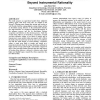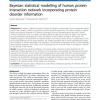140 search results - page 21 / 28 » On the submodularity of influence in social networks |
GECCO
2008
Springer
13 years 8 months ago
2008
Springer
This study proposes an agent-based model where adaptively learning agents with local vision who are situated in the Prisoner’s Dilemma game change their strategy and location as...
HUC
2011
Springer
12 years 7 months ago
2011
Springer
As ubiquitous computing becomes increasingly mobile and social, personal information sharing will likely increase in frequency, the variety of friends to share with, and range of ...
JAIR
2008
13 years 7 months ago
2008
It is well-known that acting in an individually rational manner, according to the principles of classical game theory, may lead to sub-optimal solutions in a class of problems nam...
BMCBI
2010
13 years 7 months ago
2010
Background: We present a statistical method of analysis of biological networks based on the exponential random graph model, namely p2-model, as opposed to previous descriptive app...
DGO
2007
13 years 9 months ago
2007
Although the research domain on social capital and the adoption of Information and Communication Technologies (ICTs) is relatively immature, there is a fast growing body of eviden...


